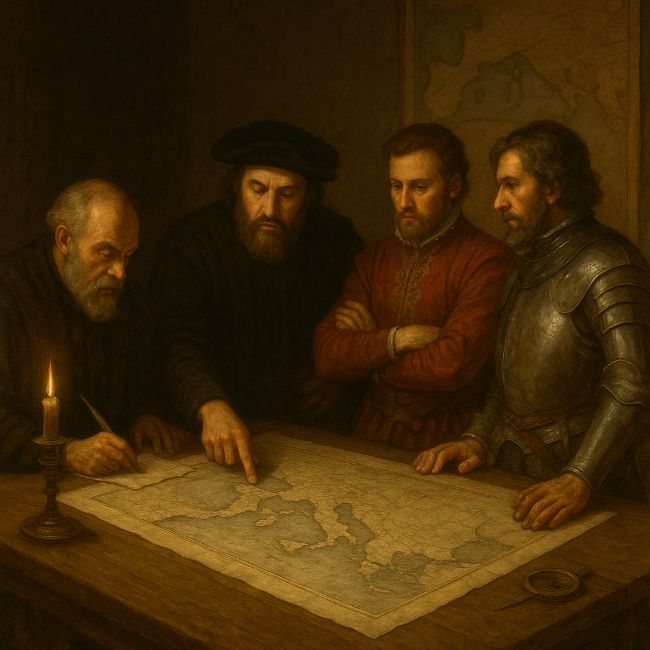| Malta Short Let: Cozy Stay in Gzira | |
|
Sliema Area Modern Designer Finished 2 Bedrooms + Games Room. First floor with Maltese Balcony Large back Terrace with swinging sofa Fully Airconditioned + Full Kitchen 3 TVs, including 65” with backlight. |
 |
|
Book Now: Google Travel | Direct (Cheapest) | Booking.com | Airbnb |
|
A 1565 Intelligence Coup
How Spanish spies infiltrated Ottoman war councils and changed the course of Mediterranean history
December 1564, Istanbul. In the naval arsenal’s war room, Ottoman admirals and viziers gather around maps of a small Mediterranean island. They don’t know it yet, but every word they speak is being carefully noted by Spanish intelligence. Within weeks, their battle plans will land on King Felipe II’s desk in Madrid.
This is the untold story of the 1565 Siege of Malta—not from the perspective of heroic knights or Ottoman warriors, but through the eyes of the spies who shaped its outcome.
The Intelligence Bombshell
On December 7, 1564, Spanish spy handlers in Madrid received an extraordinary report marked “from a person who generally writes truthfully.” What it contained would have made any intelligence officer’s career:
A complete breakdown of the Ottoman war council meeting, including:
- Exact troop numbers: 25,000-30,000 soldiers, including 4,000-5,000 elite janissaries
- Precise logistics: 130 galleys, 60 heavy cannons, 25,000 iron cannonballs
- The strategic debate: Admiral Piyale Pasha arguing for Fort St. Elmo first (to secure the fleet), while General Mustafa Pasha wanted to attack the main fortifications immediately
- Even motivational tactics: fatwas promising martyrdom to anyone who died within ten years of the campaign
The Spanish had effectively bugged the Ottoman Empire’s Pentagon.
The Djerba Disaster: Why Spain Was Desperate
To understand why this intelligence mattered, we need to rewind to 1560. The Spanish fleet had just suffered a catastrophic defeat at Djerba—think of it as Spain’s Pearl Harbor. The Ottoman navy had surprised and routed the Spanish forces, capturing numerous galleys and commanders.
Spain’s response? A complete strategic pivot:
- Build 150 new galleys (financed by papal taxes)
- Avoid direct naval confrontation at all costs
- Play defense until strong enough to strike back
The Malta intelligence arrived at the perfect moment. Spain couldn’t match Ottoman naval power, but with advance warning, they could prepare the perfect counterpunch.
The Siege Unfolds—Exactly as Predicted
When the Ottoman fleet arrived at Malta on May 19, 1565, the Spanish weren’t surprised. The intelligence had been spot-on:
- The Ottomans started with Fort St. Elmo, just as the intercepted plans indicated
- They brought the exact artillery reported: those 60 heavy cannons
- The 25,000 cannonballs? The Ottomans fired an astounding 70,000 at St. Elmo alone
But here’s where Ottoman planning met reality: Fort St. Elmo was supposed to fall quickly. Instead, it held for 31 brutal days, devouring Ottoman ammunition, time, and most critically, momentum. This resistance proved crucial in comparing the military tactics of the two great sieges of Malta.
The Secret Relief Operation
While the Ottomans bled themselves against Malta’s fortifications, Spain’s Captain-General García de Toledo executed perhaps the most daring special operation of the 16th century.
The challenge was mind-boggling:
- Land 9,600 elite soldiers on an island surrounded by 130+ Ottoman warships
- Do it without triggering a naval battle Spain couldn’t win
- Find a landing spot the Ottomans hadn’t fortified
Spanish reconnaissance identified a narrow window: Ottoman patrols had gaps in coverage at Melecha Bay in northern Malta. On September 7, in a pre-dawn operation that would make modern special forces proud, Spanish forces landed their entire relief force in just 90 minutes. The operation was so smooth that Spanish records note “not even a single oar was lost.”
The Intelligence Victory That Changed Everything
The Ottoman commanders woke up to find nearly 10,000 fresh enemy troops behind their siege lines. Already weakened by disease, running low on supplies, and having lost 20,000 men, Mustafa Pasha made the only sensible decision: retreat.
By September 12, the Ottoman forces had evacuated. The “inevitable” Ottoman conquest had become an embarrassing withdrawal. This defeat would echo through the Ottomans after the Great Siege of Malta.
The Fatal Flaw: Why the Ottomans Never Learned
Here’s the most striking part of this story: the Ottomans never fixed their intelligence problem.
Just six years later at Lepanto (1571), they fell into the same trap. Despite commanding 230+ galleys, they were blindsided by:
- The Holy League’s new galleass warships
- The exact location and timing of the Christian fleet
- The unprecedented coordination between Spanish, Venetian, and Papal forces
The pattern was clear: while the Ottomans kept winning through superior numbers and traditional tactics, they kept losing the intelligence war.
See also similar sieges to the Great Siege of Malta.
The Empire That Couldn’t Adapt
Why didn’t Malta serve as a wake-up call? The answer reveals the Ottoman Empire’s tragic flaw:
1. Institutional Arrogance: The Ottomans had dominated the Mediterranean for so long, they couldn’t conceive that Christian powers had surpassed them in intelligence gathering.
2. Structural Blindness: As Ottoman governance became more palace-centered, they lost the distributed intelligence networks that early sultans had cultivated. The corsairs who provided tactical intelligence couldn’t penetrate European courts.
3. Technological Stagnation: While Spain professionalized its intelligence service—creating dedicated budgets, permanent spy networks, and systematic analysis—the Ottomans relied on the same methods that had worked against less sophisticated opponents.
The documents reveal a telling detail: Ottoman commanders at Malta admitted being “surprised” by the relief force, despite Spanish preparations taking months. This wasn’t bad luck—it was systematic failure.
The Lesson That Echoes Today
The 1565 Siege of Malta wasn’t just a military turning point—it marked the beginning of the Ottoman Empire’s intelligence deficit that would plague them for centuries. They had pioneered intelligence techniques like the çavuş messenger system, but failed to evolve when European powers revolutionized espionage.
In modern terms, the Ottomans were still using carrier pigeons while their enemies had invented the telegraph.
The Spanish didn’t need to match Ottoman military power ship-for-ship. They just needed to know where and when to apply the force they had. And crucially, they needed to keep learning and adapting their intelligence methods.
The Ultimate Irony
The mighty Ottoman Empire—which had built its expansion on superior information networks, from merchant spies to diplomatic intelligence—lost its edge precisely when intelligence mattered most. Their failure to learn from Malta wasn’t just a military defeat; it was the beginning of a strategic blindness that would contribute to centuries of gradual decline.
Understanding the Ottoman Empire’s rise and how it led to the Great Siege makes this intelligence failure even more tragic. The same empire that had mastered information warfare forgot its most crucial lesson.
The next time you visit Malta’s historic fortifications or explore the Knights of Malta’s legacy, remember: the real story isn’t just about courage and cannons. It’s about an empire that forgot the first rule of warfare—know thy enemy—and paid the price for centuries to come.
For those interested in experiencing this history firsthand, consider joining a Knights of Malta tour or exploring Fort St. Angelo, where much of this drama unfolded.
Based on previously unpublished Spanish archival documents from the Archivo General de Simancas and Archivo de Museo Naval Madrid, revealing how intelligence failures shaped the Ottoman Empire’s strategic decline.








